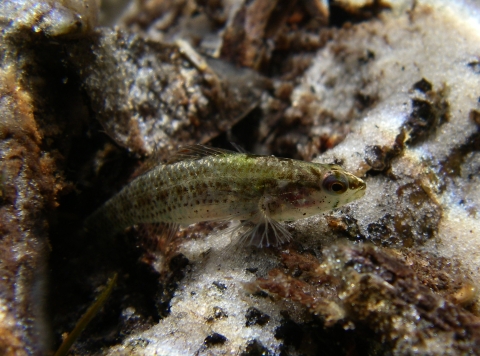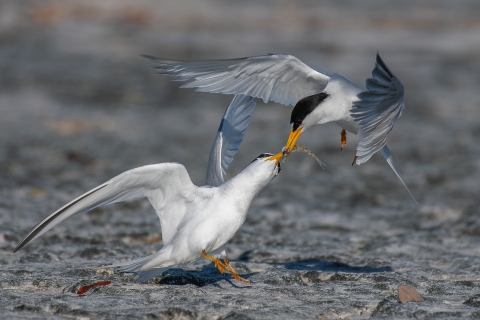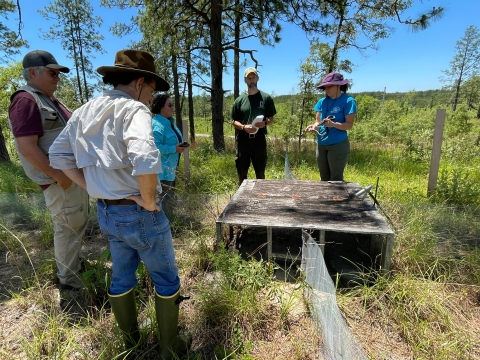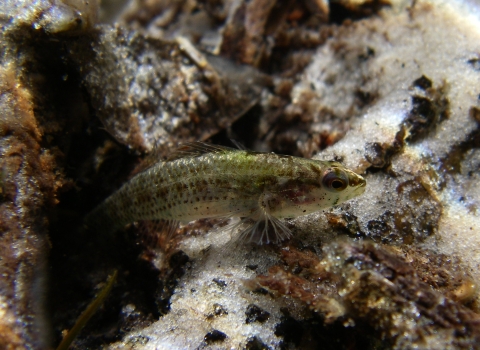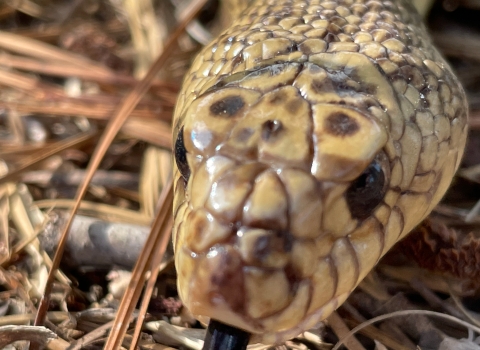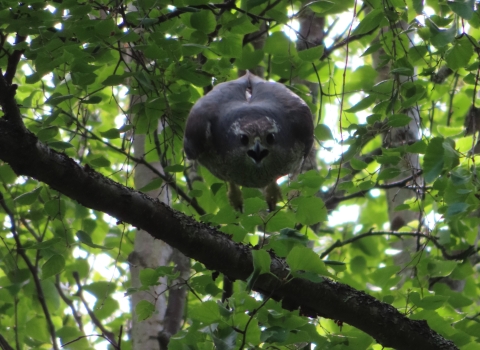For 20 years, the U.S. Fish and Wildlife Service has been recognizing the outstanding conservation successes taking place on military lands across the country through the annual Military Conservation Partner Award. This coveted award recognizes elite military installations that are able achieve natural resource conservation victories through tangible, on-the-ground programs based on cooperation and communication with partners. These wildlife defenders are on the front lines of conservation and advancing the mission of habitat restoration!
Across the country, the Department of Defense manages 26.9 million acres of lands and waters, from desert to forest, coasts to mountains, sagebrush sagebrush
The western United States’ sagebrush country encompasses over 175 million acres of public and private lands. The sagebrush landscape provides many benefits to our rural economies and communities, and it serves as crucial habitat for a diversity of wildlife, including the iconic greater sage-grouse and over 350 other species.
Learn more about sagebrush to longleaf pine. Many of these landscapes are unique and increasingly important to America’s threatened and endangered wildlife. These landscapes, both urban and remote, provide food and shelter to over 500 federally listed plant and animal species, including 55 listed species that occur only on DoD lands.
Eglin Air Force Base - 20'th Annual Military Lands Conservation Partner Award Winner
The Service is proud to recognize Eglin Air Force Base as the winner of the 20th Annual Military Lands Conservation Award for their unwavering commitment to protecting our planet's natural treasures. Their dedication to balancing military operations with conservation efforts has earned them recognition as a leader in conservation on military lands. From the endangered Okaloosa darter to the majestic red-cockaded woodpecker, Eglin has spearheaded numerous initiatives to restore and protect these vital species.
The base’s commitment to the Okaloosa darter has been an important part of helping to recover this unique fish. Over the past 25 years, they've undertaken over 500 erosion control projects, removed 20+ fish passage fish passage
Fish passage is the ability of fish or other aquatic species to move freely throughout their life to find food, reproduce, and complete their natural migration cycles. Millions of barriers to fish passage across the country are fragmenting habitat and leading to species declines. The U.S. Fish and Wildlife Service's National Fish Passage Program is working to reconnect watersheds to benefit both wildlife and people.
Learn more about fish passage barriers, and restored 17 streams—all in the name of safeguarding this precious species. Through proactive measures like erosion control projects and road rehabilitation, Eglin is setting the standard for sustainable land management practices. With their leadership and dedication, we can ensure a brighter, more sustainable future for generations to come!
Outstanding Military Conservation Partners
In 2023, installations from across the armed forces achieved major victories for conservation and held the line against habitat loss. In addition to the monumental successes of our 20'th Annual Military Lands Conservation Partner Award Winner, we are celebrating some of the most impactful Air Force, Army, Marine, Navy, and National Guard conservation partnerships from across the country!
Naval Weapons Station Seal Beach: Flying Free
The partnership between Seal Beach National Wildlife Refuge and Naval Weapons Station Seal Beach is a shining example of successful collaboration. Together, they are safeguarding a nesting colony of endangered California least terns, working together with partners to release captive bred endangered light-footed Ridgeway’s rails, and monitoring a green sea turtle population. This unique alliance is crucial for the survival of these precious ecosystems in Southern California.
As the only National Wildlife Refuge completely surrounded by an active U.S. Navy base, Seal Beach National Wildlife Refuge is one of the last remnants of undisturbed native coastal salt marsh salt marsh
Salt marshes are found in tidal areas near the coast, where freshwater mixes with saltwater.
Learn more about salt marsh habitat in Southern California and serves as an important stopover point for migratory shorebirds traveling along the Pacific Flyway. This island of safe habitat in the midst of a dense urban setting rely on the partnership with Naval Weapons Seal Beach!
U.S. Army Fort Leonard Wood: Migration Maneuvers
Deep in the heart of the Ozark plateau, Fort Leonard Wood is forging ahead to protect endangered species habitat and ensuring hellbenders and other aquatic wildlife can complete their migration maneuvers on the Big Piney River. Through using eDNA surveys to find undocumented mussel locations within the Big Piney River and Roubidoux Creek, to monitoring black bears and mountain lions, controlling invasive species invasive species
An invasive species is any plant or animal that has spread or been introduced into a new area where they are, or could, cause harm to the environment, economy, or human, animal, or plant health. Their unwelcome presence can destroy ecosystems and cost millions of dollars.
Learn more about invasive species like emerald ash borer, and improving roads to protect stream health, Fort Leonard Wood is one of our premier military conservation partnerships.
Fort Leonard occupies 63,000 acres in the center of Gasconade River Basin, an area known for heavily forested hills, and narrow floodplains bordered by sheer and steep bluffs. All of which makes Fort Leonard Wood the center of an expansive wildlife habitat that is home to five federally endangered species: gray bat (Myotis grisescens), Indiana bat (Myotis sodalis), northern long-eared bat (Myotis septentrionalis), spectaclecase mussel (Cumberlandia monodonta), and Missouri distinct population segment (DPS) of the eastern hellbender (Cryptobranchus alleganiensis alleganiensis). The important work taking place at Fort Leonard Wood is helping protect important wildlife habitat while improving recreation and preserving operational readiness.
Joint Readiness Training Center and Fort Johnson in Louisiana: Find and Protect
Joint Readiness Training Center and Fort Johnson in Louisiana is leading the charge in conservation, battling for species like the red-cockaded woodpecker, the Louisiana pine snake, the alligator snapping turtle, and the Louisiana pigtoe mussel. For two decades, they've been on the frontlines alongside the USFWS and Louisiana Department of Wildlife and Fisheries, protecting habitats and species while fulfilling their military training mission.
Through strategic alliances with universities, they've launched important initiatives, like using eDNA to track elusive species. Their dedication to protecting the Louisiana pine snake is a testament to their strong commitment to conservation. Recognized as one of the last strongholds of the iconic snake’s habitat, Fort Johnson employs a strategic, multi-year approach to safeguarding this species and its habitat while fulfilling its military training mission. In 2023, Fort Johnson made significant contributions to Louisiana pine snake conservation, providing a wild-captured male a captive breeding program and participating in the release of captive-bred snakes into the Kisatchie National Forest. Joint Readiness Training Center and Fort Johnson are outstanding wildlife conservation partners, protecting wildlife and their habitats for generations to come!
Marine Corps Air Ground Combat Center: Slow and Steady Wins the Race
We salute the Marine Corps Air Ground Combat Center for their outstanding conservation efforts, which not only support sustainable military training but also contribute significantly to the recovery of the desert tortoise. They've been leading the charge regionally, from translocating tortoises to critical habitat areas to running their Tortoise Research and Captive Rearing Site facility. Their strategic approach includes predator management, predator control, and extensive habitat restoration.
Their commitment to the Recovery and Sustainment Partnership initiative is commendable, with actions ranging from habitat restoration to community outreach. Through collaboration with agencies like the Department of the Interior, National Fish and Wildlife Foundation, BLM, and Fort Irwin they're making strides in desert tortoise recovery. Their efforts have not only minimized the impact of training on tortoise populations but have also had positive effects on the region. Their unwavering commitment to protecting natural resources while fulfilling their military mission is truly exemplary.
Camp Edwards: Leaping into Conservation Partnerships
At Camp Edwards in Massachusetts, a formidable coalition is fighting the good fight to protect imperiled wildlife and habitats. Camp Edwards sits amidst the largest pine barrens system north of New Jersey, making it a vital sanctuary for more than 20 state-listed species and the federally listed Northern long-eared bat. From the delicate frosted elfin moth to the iconic eastern whip-poor-will, all sorts of species have benefited from the efforts of Camp Edwards' Natural Resources staff.
Through a strategic combination of research, management, and collaboration, Camp Edwards has emerged as conservation champion for imperiled species like the New England cottontail. The discovery of New England cottontail at Camp Edwards reignited support for using fire as a conservation tool and helped prevent the species from becoming listed under the Endangered Species Act in 2015. The positive effects of all that habitat management are rippling out to benefit other species as well, and populations of birds like prairie warblers and scarlet tanagers are on the rise, defying broader trends of decline.
Avon Park Air Force Range: Fanning the Flames of Conservation
Avon Park Air Force Range is fanning the flames of conservation and preserving Florida's precious endemic habitats and species across its 106,000-acre stronghold. Avon Park conducts an impressive array of operations, from battling invasive species across thousands of acres to orchestrating meticulously controlled prescribed fires that breath new life into ecosystems and provide a lifeline for species like the red-cockaded woodpecker, Florida grasshopper sparrow, and Florida scrub-jay, who depend on the rejuvenating power of fire. Their success in surpassing recovery goals for red-cockaded woodpeckers and reintroducing Florida grasshopper sparrows from the brink of extinction is nothing short of heroic.
Avon Park Air Force Range is an outstanding military conservation partner and an example of collaboration between the Department of Defense and Department of Interior. Together, we can ensure that future generations inherit a world rich in biodiversity and beauty.
Camp Grayling Joint Maneuver Training Center at Grayling, Michigan: Tracking Success
Camp Grayling, the largest National Guard facility in the United States, has emerged as a conservation powerhouse, actively managing its natural resources to protect and conserve state and federally listed species. Notably, Camp Grayling serves as a leader in the conservation of the eastern massasauga rattlesnake and has worked with the conservation community and the National Guard to pioneer educational initiatives to ensure the safety of both troops and wildlife.
Camp Grayling's commitment to habitat management extends to other imperiled species. Whether they are partnering with Purdue University to track Blanding’s turtles or surveying Kirtland's’ warblers their strong commitment to conservation has a direct benefit for the wildlife that call the base home. And through initiatives like the native seed partnership with Huron Pines, Camp Grayling is not only restoring training lands but also promoting ecological restoration and pollinator habitat.
Overall, Camp Grayling's landscape-scale natural resource management efforts serve as a model for balancing military training needs with conservation objectives. By actively coordinating with governmental agencies and fostering partnerships, they demonstrate how proactive conservation measures can benefit both military operations and biodiversity conservation in complex landscapes.
Marine Corps Base Hawaiʻi: Community Conservation
Marine Corps Base Hawaiʻi is home to the rich biodiversity of Hawaiʻi, and plays a crucial role in safeguarding endangered and threatened species such as the Hawaiian stilt, Hawaiian gallinule, Hawaiian coot, and Hawaiian duck, alongside over 50 species of native and migratory birds.
In recognition of the cultural and biological importance of its natural resources, the base has committed to a broad range of conservation initiatives that rely on strong partnerships and foster community engagement. They have implemented measures to improve habitat for Hawaiian stilts reduce light-induced seabird fallout, control invasive species, and conduct seabird social attraction studies. Additionally, MCBH actively collaborates with researchers to study and monitor endangered species such as the Hawaiian short-eared owl and yellow-faced bee, ensuring proactive conservation efforts are in place.
Overall, the base’s multifaceted approach to conservation not only supports the survival of endangered species but also promotes ecological resilience and fosters a deeper connection between military personnel, local communities, and the natural world.
Past Military Conservation Partner Award Winners
| Year | Military Installation |
|---|---|
| 2004 | U.S. Army Fort Carson, CO |
| 2005 | U.S. Army Fort Riley, KS |
| 2006 | U.S. Army Pohakuloa Training Area, HI |
| 2007 | U.S. Army White Sands Missile Range, NM |
| 2008 | U.S. Army Garrison, Hawaii: Schofield Barracks, HI |
| 2009 | U.S. Army Fort Stewart, GA |
| 2010 | U.S. Army Umatilla Chemical Depot, OR |
| 2011 | U.S. Air Force Academy, CO |
| 2012 | Naval Station San Diego, CA |
| 2013 | Idaho National Guard Orchard Combat Training Center, ID |
| 2014 | Vandenberg Air Force Base, CA |
| 2015 | Barry M. Goldwater Range, AZ |
| 2016 | Fort Hood, TX |
| 2017 | Camp Blanding, FL |
| 2018 | Fort McCoy, WI |
| 2019 | Fort Knox, KY |
| 2020 | Camp Shelby, MS |
| 2021 | Camp Pendleton, CA |
| 2022 | JBMDL, NJ |
| 2023 | Eglin AFB, FL |

